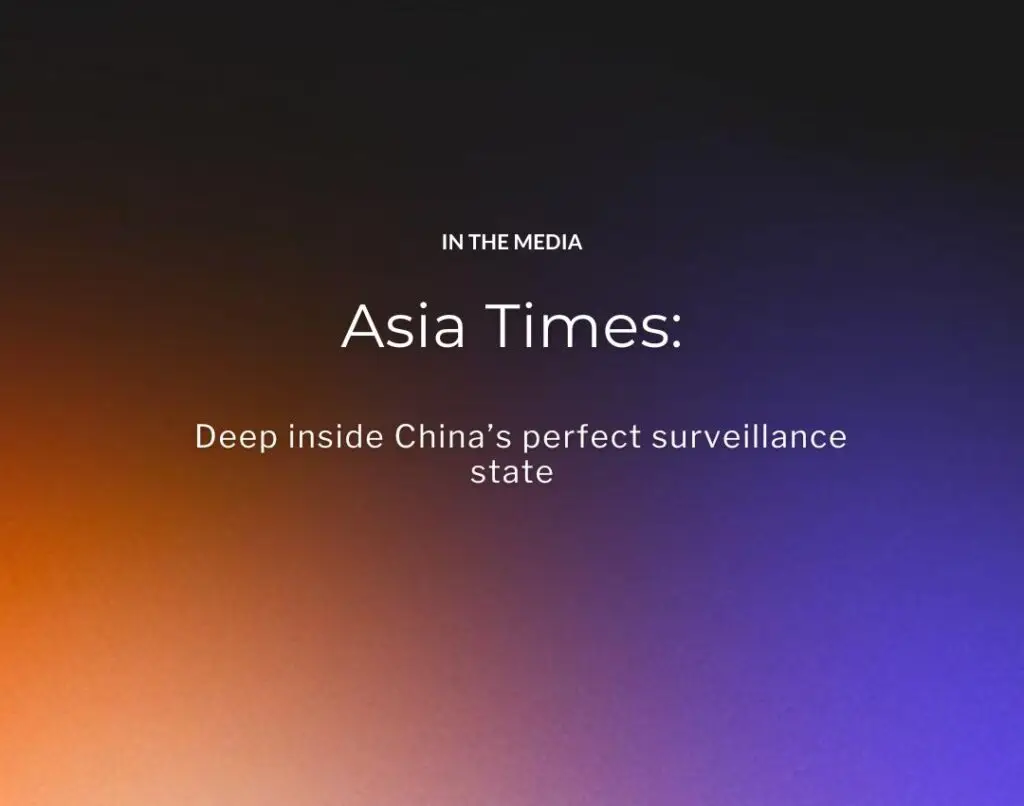New book details how Beijing adopted, integrated and applied technologies to suppress its Uighur minority in Xinjiang
By Andrew Salmon
Asia Times
June 29, 2021

Merge the fantastical science of Mary Shelley’s Frankenstein with the dystopian politics of George Orwell’s 1984 and the doomsday scenario of James Cameron’s Terminator movie franchise and you might feasibly come up with Geoffrey Cain’s The Perfect Police State, published Tuesday by Hachette Book Group in the US.
But fiction be damned. Cain’s work – sub-titled an Undercover Odyssey into China’s Terrifying Surveillance Dystopia of the Future – is fact.
Shelleyian? Sure – the “modern Prometheus” exists, but it is a fizzing, spitting blend of electronic hardware and software rather than an electrically animated mismatch of body parts.
Orwellian? Sure – thought crime is actually being prosecuted and punished. And Cameronian? Sure – the invasive technology platform Beijing has deployed in China’s northwestern province is actually branded “Skynet,” or Tianwang.
It is to this restive province – beard on chin, pack on back, sanitized smartphone in pocket and voice recorder built into the watch on his wrist – that Cain takes the reader in his dense and detailed 279-page work.
High-tech terra incognito
Xinjiang, on China’s northwestern frontier, slots into a broader geography that is largely alien to the West: The great central Eurasian landmass, stretching from China to Russia, encompassing the ‘Stans and the Caspian, Aral and Black Seas. A vast space which European empires barely penetrated, let alone dominated.
This is where the Mongolian, Sinic, Ottoman, Czarist and Soviet Imperiums went about their business, on and around the Silk Road.
American Cain is a globe-trotting writer who has reported from both Koreas, China, Japan, Russia, Turkey and Vietnam. He has been accused of spying for the CIA by Cambodia’s government and is a member of the New York-based Council for Foreign Relations. He also previously contributed journalism to Asia Times.
However, his brief is tech, on which he has advised both the US financial and political establishments. His previous book, the award-winning Samsung Rising, dived under the hood of the world’s biggest electronics company.
Never before have personal technologies been so ubiquitous. Yet from fire and flint tools to internal combustion engines and computers, they have always been double-edged, applied for purposes good and ill.
The heady days when the internet was viewed as the liberating technology of the Arab Spring are long gone. Today, criminals and disinformationists roam the web and some capitals – notably Beijing – have reverse engineered IT to watch the watcher.
The latter is Cain’s story. In fact, The Perfect Police State tells several different but convergent stories.
One is the rise of President Xi Jinping and China’s confrontation with the West. Another is the position and fate of Xinjiang. The third and over-arching narrative covers how China created extraordinary machinery of surveillance to oversee and suppress Xinjiang’s Uighur minority.

Xi’s eye on Xinjiang
Xi, having suffered through the chaos of the Cultural Revolution, was drawn to order and “obedient patriotism.” After multiple attempts, he entered the Chinese Communist Party, trained as an engineer and rose through the ranks.
As China became richer but more corrupt, Xi pinpointed the flaws. In 2012, he was elected CCP general secretary, where he was not “afraid to bust corrupt officials, shake up the system, or make enemies.” In 2013, he became president.
A believer in military power, Cain writes, Xi also sought to reclaim China’s past glories, when it collected tribute from around the region and spread influence far and wide. With China’s east blocked off by South Korea, Japan and the US, Xi’s gaze turned west – to Eurasia and the Silk Road.
This would become Beijing’s nascent influence-capturing Belt and Road Initiative. Its gateway led through Xinjiang.
On the edge of the Taklamakan (“Go in and Don’t Come Out”) Desert, Xinjiang (“New Dominion”) was once China’s Wild West. Inhabited by Turkic Muslims – the Uighurs – it was taken by communist forces in 1950.
For half a century, the Bingtuan (“The Corps”), a collective of retired military, was the unofficial provincial controller, firming up the border, consolidating and expanding landholdings. From the turn of the millennium, it oversaw a massive influx of Han Chinese migrants into Xinjiang.
The resultant situation is one Cain considers akin to apartheid, but millennial Uighurs were subject to both push and pull dynamics.
In 2009, protests against economic inequality and cultural restrictions broke out. And from that year onward, under the heady influence of jihad, Uighur militants exfiltrated China after being in combat in Afghanistan and Syria.
The Americans captured a handful. However, US operatives only belatedly realized – after allowing Chinese colleagues into Guantanamo Bay to interrogate them – that the Uighur prisoners were not global jihadis, but fighters arrayed against Beijing.
In 2013 and 2014, terrorist attacks – bombings and knife rampages – shook China. Beijing, identifying the three feared forces of “separatism, extremism and terrorism,” turned its most baleful gaze upon the Uighurs..
In the words of one interviewee, a new mood of “hysteria, accusation, and paranoia” prevailed. Xinjiang was transformed into “a testing laboratory for the most cutting-edge surveillance technologies of a dystopian future,” Cain writes.

‘The Situation’
What prevails is the state of surveillance and oppression that Uighurs dub “The Situation.”
To detail it, Cain engages multiple information sources – official, corporate and tech reports, interviews with overseas experts – and adds color from his own trips to China and Xinjiang. But his top sources are three Uighur witnesses – all exiles.
One is a technology professional who gradually turns against his work and his masters. Another is a female scholar who encounters Han prejudice against Uighurs when she attends an elite university in Beijing before being imprisoned – in a Kafkaesque bureaucratic and technical error – to the much-feared “re-education” gulag in Xinjiang.
And one is a wannabe freedom fighter who is arrested and turned. He is coerced into spying on his extended family, before deploying abroad to infiltrate terrorist cells in Afghanistan and expatriate Uighur networks in Turkey.
Central to “The Situation” is a concept called a “panopticon” – a prison set up in a circular format, in which a guard can see everything from a sentry post in the center, but from which he cannot be seen. The tool is “Skynet” – a dark masterpiece of systems integration that is unmatched in the history of spookery.
Skynet’s origins date back to 2005, though it would not reach maturity for another 11 years. Most component technologies – at least, prior to their integration in Skynet – were acquired via cooperation with Western academia, and companies including Microsoft, Qualcomm and Nvidia.
Regarding Chinese companies, Huawei’s network equipment, Hikvision’s CCTV cameras and WeChat’s data were key pillars, Cain writes.
Skynet’s early base was metadata garnered from WeChat, enabling the state to map out relationship patterns via user contacts. Supplementing this data pool, WeChat added features that allowed users to conduct transactions, make appointments, book transport, meet dates and manage investments. Social media and state security information deepened the information mine.
All this data needed a brain. By the 2010s, Chinese computer scientists were approaching the “holy grail” of surveillance technology: A “deep neural network” that could establish patterns between countless images and data points. The software could connect dots, and learn from the data.
A1 became the mind to mine the data. Skynet’s “eyes” – unblinking CCTV cameras – were linked to non-sleeping AI via the web, instead of to banks of TVs overseen by human monitors. Through CCTV lenses, AI was synched with facial recognition software.
Voice recognition software added “ears” to the system. Blood and flesh came via DNA samples.
In addition, security agencies required people to download specific apps on their devices that hacked further into their data and networks. Even low-tech products are not exempt from high-tech surveillance: Knifemakers were required to lase customers’ QR codes into their products.
Meanwhile, in a society largely without credit cards, Chinese mobile fintech companies had to innovate credit ratings for their tens of millions of users. Based on this model, state security created “trust” ratings.
The end result of these various developments converged in 2016 when “predictive policing” was instituted. Under this, AI algorithms pinpoint high-risk individuals, who are referred to security agencies for investigation and possibly detention. Having relatives overseas, praying, fasting and engaging in religious activity were just some indicators of pre-crime, Cain claims.
In the physical world, police were armed with scanning devices on their smartphones and sunglasses embedded with spy cams – all networked with Skynet.
Old-school human intelligence was another component.
Resurrecting a feudal Sinic system designed to aid tax collection, Xinjiang households were organized into groups of 10 homes whose residents were responsible for monitoring each other’s activities and visitors. Between 2014 and 2018, Beijing deployed 200,000 party cadres to Xinjiang to head these collectives.
Campaigns leveraged Uighurs from their culture. One source, after being forced to install an always-on CCTV camera in her living room, was ordered to repaint her home interior in Communist red, rather than the pale blue that represents Uighur independence.
Traditional buildings, mosques and old neighborhoods were bulldozed. “China’s goal was to erase one people’s identity, culture, and history and to achieve a total assimilation of millions,” Cain writes.
By 2017, according to one source, those imprisoned within Xinjiang’s detention and re-education camps had reached 1.5 million, of a Uighur population of 11 million. Detainees in Xinjiang made up 21% of all arrests in China that year, despite the province holding only 2% of the national population.
For those trapped within it, “The Situation” became nightmarish.
One source – within hours – was shuttled from a police station, where she had been ordered for an interview, to a one-day camp, then to a re-education camp with no time set for release. The internee was shackled into a “tiger chair” – an iron seat – and broiled in the sun for eight hours.
But Cain makes clear that physical torture – which includes beatings with spiked rubber batons – is a lesser evil than the mental abuse. The language in these facilities merges biology with technology: The imprisoned must “cleanse their minds” of “ideological viruses.”
Teachings and programs suppress inter-human trust and critical thinking. Those who exit the centers are “… like patients who’d recovered from the head trauma of a car crash and lost their personalities,” a survivor says. “They didn’t seem able to think, ask questions, show emotion, or speak.”
The deprogrammed provided ideal fodder for another institution: commerce. As increasing numbers of Chinese entered the middle class, Uighurs were deployed to take their place as labor. Cain’s sources claim some 80,000 were transferred to work sites – including, allegedly, centers run by Adidas, Amazon and Gap.
Could it happen here?
The Gestapo, KGB and Stasi – thankfully – never had access to a system as all-pervasive as the Skynet that looms over Xinjiang. Cain’s work reads almost like a textbook for cyber-age secret policemen and dictators as he details how Beijing slaved technology to policy and shackled private sector commercial advances to Communist party goals, creating a system with demonic capabilities.
The Perfect Police State is not a perfect book. As Cain’s chapters leap between political maneuvers, technological advances and the misfortunes of key characters with no strict timeline in place, this reviewer frequently found himself confused.
Yet it is a compelling read. One that, moreover, plunges into mission-critical millennial matters – the rise of China; the dual-use nature of many of the personal technologies we take for granted – and the timeless perennial, man’s inhumanity to man.
It is also a timely work, given that the surveillers are, themselves, being surveilled. With China the new all-American enemy and East-West rivalry bubbling away, Beijing’s police state is very much in the crosshairs of Western governments and media – with this book being the latest, most detailed probe.
Alas, and inevitably, the work is unfinished; no happy ending is in sight. Multiple indications are that, amid Covid-19, “The Situation” worsened and Uighur birth rates are plummeting.
Even for those who have no intention of ever visiting China or Xinjiang, this book is recommended.
History shows that no technology can de-invented. And the majority of technologies Beijing has embedded in Xinjiang are based on – or are a repurposing or an improvement of – those in widespread use in democracies.
In his afterward, Cain notes that hundreds of US police departments have deployed facial recognition software and AI in crime fighting, with dubious results. Moreover, many emergency powers adopted by governments around the world to combat Covid-19 lack sunset provisions.
This raises worrisome questions. Beyond the borders of authoritarian states, are democratic systems and rule of law sufficient to insulate you and I from the infiltration of invasive technologies?
Or is the entire grid that we rely on for so much of our work, socialization, communication, commerce and information already a super Xinjiang – buzzing away on the edge of our consciousness, quietly gathering data and merely awaiting activation?
Asia Times will run an exclusive interview with author Geoff Cain on Wednesday.
See Also:





